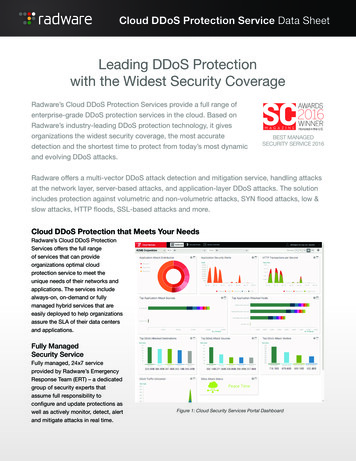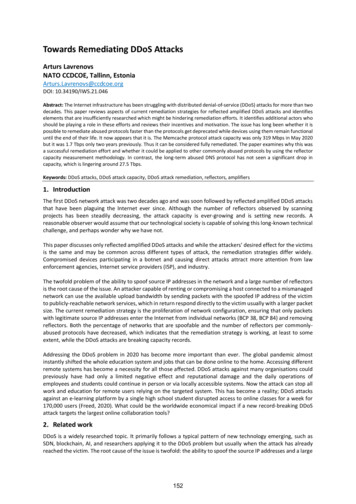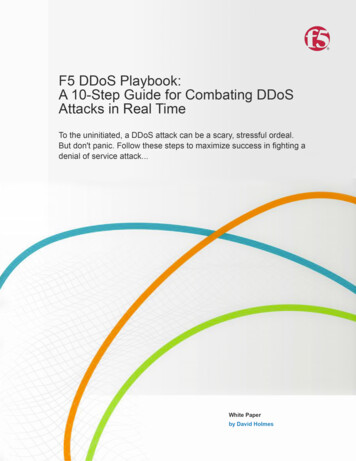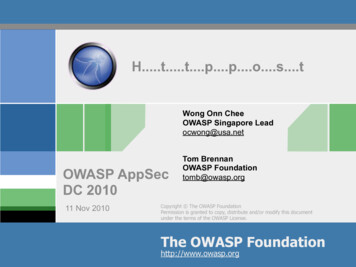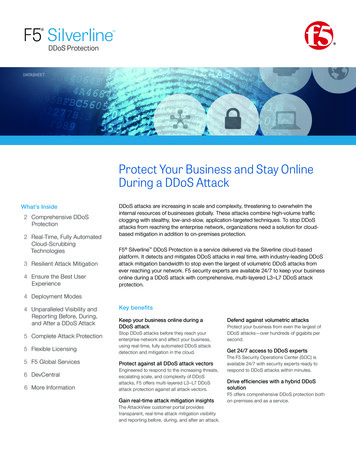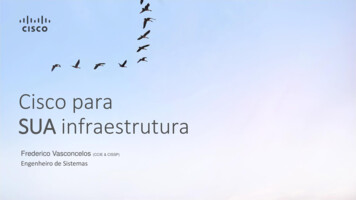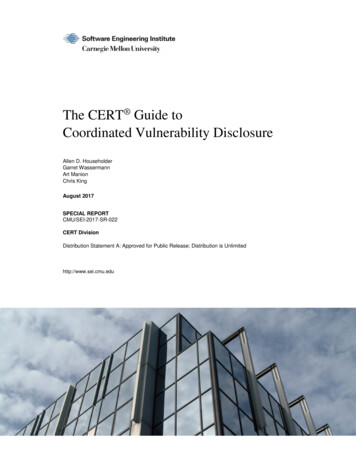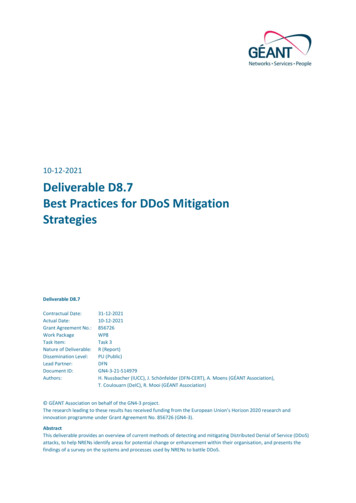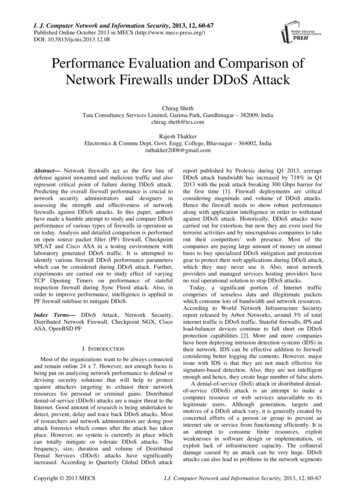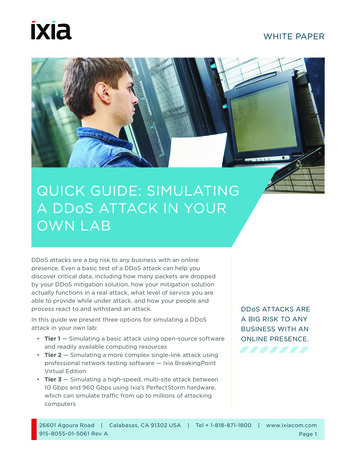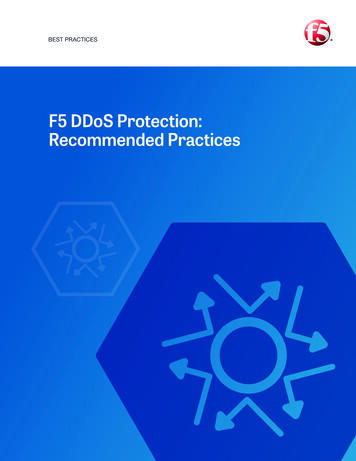
Transcription
TsuNAME vulnerability and DDoS against DNSISI Technical Report ISI-TR-74013 May 2021Update from 6 May 2021https://tsuname.ioGiovane C. M. Moura (1)Sebastian Castro (2)Wes Hardaker (3)1: SIDN Labs2: InternetNZABSTRACTThe 1 Internet’s Domain Name System (DNS) is one of thecore services on the Internet. Every web page visit requiresa series of DNS queries, and large DNS failures may havecascading consequences, leading to unreachability of majorwebsites and services. In this paper we present TsuNAME,a vulnerability in some DNS resolvers that can be exploitedto carry out denial-of-service attacks against authoritativeservers. TsuNAME occurs when domain names are misconfigured with cyclic dependent DNS records, and when vulnerable resolvers access these misconfigurations, they begin looping and send DNS queries rapidly to authoritativeservers and other resolvers (we observe up to 5.6k queries/s).Using production data from .nz, the country-code top-leveldomain (ccTLD) of New Zealand, we show how only twomisconfigured domains led to a 50% increase on overall traffic volume for the .nz’s authoritative servers. To understandthis event, we reproduce TsuNAME using our own configuration, demonstrating that it could be used to overwhelmany DNS Zone. A solution to TsuNAME requires changes tosome recursive resolver software, by including loop detection codes and caching cyclic dependent records. To reducethe impact of TsuNAME in the wild, we have developed andreleased CycleHunter, an open-source tool that allows forauthoritative DNS server operators to detect cyclic dependencies and prevent attacks. We use CycleHunter to evaluateroughly 184 million domain names in 7 large, top-level domains (TLDs), finding 44 cyclic dependent NS records usedby 1.4k domain names. However, a well motivated adversarycould easily weaponize this vulnerability. We have notifiedresolver developers and many TLD operators of this vulnerability. Working together with Google, we helped them inmitigate their vulnerability to TsuNAME.1INTRODUCTIONThe Internet’s Domain Name System (DNS) [18] provides oneof the core services of the Internet, by mapping hosts names,1 Thisversion is an update from the original version of May 6th, 2021. Itclarifies the relationship between TsuNAME and RFC1536, and adds §6,which covers the threat model.John Heidemann (3)3: USC/ISIapplications, and services to IP addresses and other information. Every web page visit requires a series of DNS queries,and large failures of the DNS have severe consequences thatmake even large websites and other internet infrastructurefail. For example, the Oct. 2016 denial-of-service (DoS) attack against Dyn [4] made many prominent websites suchas Twitter, Spotify, and Netflix unreachable to many of theircustomers [29]. Similarly, a DDoS against Amazon’s DNSservice affected service for a large number of services [45]in Oct. 2019.The DNS can be seen as a hierarchical and distributed database, where DNS records [19] are stored in and distributedfrom authoritative servers [10] (for instance, the Root DNSservers [38] distribute records from the Root DNS zone [39]).As such, all information about an end domain name in theDNS are served by authoritative servers for that domain. Thisinformation is typically retrieved by recursive resolvers [10],which answer questions originally posed by users and theirapplications. Recursive resolvers are typically operated by auser’s ISP, or alternatively public DNS resolvers operated byGoogle [8], Cloudflare [1], Quad9 [31], Cisco OpenDNS [27]and others.The configuration of authoritative servers and their recordsis prone to several types of errors [2, 16, 18, 28, 42]. In specific, loops can be introduced while setting authoritative DNSservers for delegations– either using CNAME records (§3.6.2in [18]) or NS records (§in 2 [16]), also known as cyclic dependencies [28]). While such loops existence has been documented, in this work we show how they can be weaponizedto cause DDoS.In specific, we examine the case of cyclic dependency, anerror which occurs when NS records for two delegationspoint to each other. Since NS records define authoritativeservers used to resolve a domain [18], when a cyclic dependency occurs, neither name can be definitively resolved.For example, suppose that the NS record of example.orgis cat.example.com, and the NS record of example.com ismouse.example.org. This misconfiguration (example.org example.com)creates a situation in which resolvers cannot retrieve the IP
G. C. M. Moura et al.12001000800600400Cyclic Dependency200Day (2020)Domain B227/02/0202/013/006/030Domain A201Daily Queries (million)USC/ISI Technical Report, May 6, 2021, Marina del Rey, California, USAAll DomainsFigure 1: Queries timeseries for all domains and cyclicdependent domains (A and B)addresses associated with NS records for either zone. Without these addresses, recursive resolvers are unable to answerany questions from their clients about that portion of theDNS tree below these delegation points2 .The first contribution of this paper is to report that, in thewild, cyclic dependencies can result in a query cascade thatgreatly increases traffic to authoritative servers. An example of this problem is the .nz event (§2). On 2020-02-01, aconfiguration error (i.e., not an intentional attack) resulted intwo domains being misconfigured with cyclic dependent NSrecords. That, in turn, was followed by a 50% traffic volumesurge to the the authoritative servers for the country-codetop-level domain (ccTLD) of New Zealand (.nz), from 800Mto 1.2B daily queries (shaded area in Figure 1). This eventdid not disrupt the .nz authoritative servers. However, thesame misconfiguration can also lead to even far more queries,depending on the domain and TLD: after we disclosed thisvulnerability to TLD operators , an European ccTLD sharedwith us that it had experience 10x traffic growth after twodomains where misconfigured with cyclic dependencies .These examples bring us to question: what would happenif an attacker would intentionally misconfigure hundreds ofdomains this way, at the same time? The .nz event demonstrates what only two domains can do, but a motivated attacker could cause a far larger traffic surge, which could ultimately overwhelm authoritative servers, affecting all theirusers, and possibly affecting additional zones due to collateral damage . This poses a great concern for any domainsand registrations points, such as TLDs and ccTLDs. Criticaldomains, and ccTLDs in particular, frequently provide essential services to their users, such as access to governmentservices, banking and on-line shopping.Our second contribution is to demonstrate this threat incontrolled conditions in §3. We emulate a TsuNAME eventby setting up multiple cyclic dependent domain names underour control on our servers (so as to not harm others) and2 Althoughparent authoritative servers provide IP addresses for NS recordswithin a child domain (known as glue records), they cannot provide themfor NS records that exist in other zones.measure the consequences. We show that Google’s publicDNS (GDNS) is responsible for the bulk of queries, but wealso found other vulnerable resolvers in 260 AutonomousSystems (ASes). Following responsible disclosure practices,we notified Google and other TLD and resolver operators .Google and OpenDNS, have already fixed their software.Our final contribution is to develop CycleHunter, a toolthat finds cyclic dependencies in DNS zone files (§4). Thistool allows authoritative server operators (such as ccTLDoperators) to identify and mitigate cyclic dependencies, preemptively protecting their authoritative servers from possible TsuNAME attacks. We use CycleHunter to evaluate theRoot DNS zone and 7 other TLDs ( 185M domain namesaltogether), and found cyclic dependent domains in half ofthese zones.We made CycleHunter publicly available at Github andwe thank the various contributors that have helped improvethe tool. We have carefully disclosed our findings with therelevant DNS communities .2.NZEVENTOn 2020-02-01, two domains (DomainA and DomainB) under .nzhad their NS records misconfigured to be cyclically dependent. DomainA NS records were pointed to ns[1,2].DomainB.nz,while DomainB NS records pointed to ns[1,2].DomainA.nz.This configuration error led to a 50% surge in query volumeat .nz authoritative servers (Figure 1)3 . The .nz operatorsmanually fixed this misconfiguration on 2020-02-17, afterwhich the queries to return to normal levels.2.1Query sourcesDuring the sixteen day period of the TsuNAME event (202002-[01–17]), there were 4.07B combined queries for DomainAand DomainB, with a daily average of 269M. Figure 2a showsthe top 10 ASes by query volume during the event period.The overwhelming majority (99.99%) of the traffic originatedfrom Google (AS15169), with only 324k queries from 579other ASes – the queries from Google outnumbered the otherASes by 4 orders of magnitude.For comparison, Figure 2b shows the top 10 Ases for bothdomains during the “normal” periods when there was nocyclic dependency, spanning over the 16 days before andafter the TsuNAME period (2020-01-[24–30] and 2020-02[18–28]). During this “normal” period, Google sent no more than100k daily queries for both DomainA and DomainB. During theTsuNAME period, however, Google’s query volume multiplied 5453 (Figure 2c). No other AS had an traffic growthlarger than 100x in the same period. (Google operates Google3 Ourvantage point – the authoritative DNS servers of .nz– sees onlyqueries from DNS resolvers and not directly from end users or forwaders),given that most users do not run their own resolvers and instead use theirISP’s or pubic DNS resolvers, such as the Quads1,8,9.
The TsuNAME Vulnerability and DDoS Against DNSUSC/ISI Technical Report, May 6, 2021, Marina del Rey, California, USATotal Queries (log)Query 5ns1.DomainB.nzAS M281.4M281.2M281.4M237.9M237.7M237.7M237.5MTable 1: Google queries during the .nz event1x1061000232.2.1 Interquery interval. How frequently did GDNS resolvers send .nz queries for these domains during the TsuNAMEevent? To measure this, we pick a date (2020-02-06) duringthe period and compute the inter-query interval time, i.e., thetime in-between two queries arriving from the same IP address to the .nz authoritative servers for the same queryname and type.Figure 3 shows the results (for space constraints, we showonly results for the queries highlighted in the green rowsof Table 1). We start with the NS queries to DomainA.nz. Figure 3a shows individual resolvers on the x axis, and numberof queries on they sent on the right y axis. We see that allresolvers send fewer than 10k queries. On the left y axis, weshow the interval inter-quartile range (IQR) of the time between queries (with the green line showing the median valuein ms). Given that the TTL value of these records is 86400 s (1day), we should not see any resolver sending more than onequery on this date (anycast-based resolvers cache has multiple layer of complexity, and are not always shared [25, 32]).As shown in Table 1, the bulk of queries is for A and AAAArecords of the authoritative servers of DomainA and DomainB .Figure 3b shows the results for A records of ns1.DomainA.nz.We see three categories of resolvers, according to their queryvolume, which we highlight in different colors. The firstgroup – heavy hammers – sent 162-186k queries on this day,one every 300 ms. The second group – moderate hammers –sent 75-95k daily queries, one every 590 ms – roughly thedouble of the heavy hammers. The last group, which coversmost of the addresses – is less aggressive: they sent up to10k daily queries each. Given they are more numerous thanthe other group, their aggregated contribution matters. (?2142624996323617174769314873800950969516115NS records (NS records store the authoritative server namesof a domain, while A [18] and AAAA records [44] store eachserver’s IPv4 and IPv6 addresses, respectively. These queries,however, can never be resolved in this cyclic dependent scenario, as one authoritative server keeps forwarding resolversto the other. The NS records, however, were readily availablewithin the .nz zone – which explains the lower volume ofqueries.691AS number(b) Normal period10000Growth 2.6M222.5M222.5M222.3M617Total Queries (log)(a) TsuNAME 1896016AS number(c) Growth rateFigure 2: Top 10 ASes querying for Domains A andB, for .nz. TsuNAME period: Feb. 1–17, normal period:Jan. 24–30, Feb. 18–28, 2020.Public DNS – GDNS – a large, popular public resolver service [8] and makes up 8% of all queries sent to .nz [21]).2.2ns2.DomainA.nzQuery TypeNSNSAAAAAAAAAAAAAAAAAAAAScrutinizing Google queriesThe question Why was Google solely responsible for most ofthe queries? relates to two others: How long should resolversretry when resolving domains with cyclic dependencies? Andhow aggressive should be they be when finding answers?Previous research has shown resolvers will hammer unresponsive authoritative servers [25] – with up to 8 timesmore queries, depending on the DNS records’ time-to-live(TTL) value. But in the case of cyclic dependencies, authoritative servers are responsive and resolvers bounce from oneauthoritative server to another, asking the same sequence ofquestions repeatedly. As such, cyclic dependency is differentfrom the (partial) unresponsiveness situation from [25].Given that Google was responsible for virtually all queriesduring the .nz TsuNAME event for the cyclic dependent domains (§2.1), we isolate and study the queries from Google.Table 1 shows the breakdown of the query names and typesfrom Google during the .nz event. We see that most queriesto .nz are for A and AAAA records for the two domain’s own
G. C. M. Moura et Serverssub.verfwinkel.netCRnbRecursives(nth level)e.g: ISP resolv.00140012001080060040002000ms (log)USC/ISI Technical Report, May 6, 2021, Marina del Rey, California, USACR1aResolver (sorted by queries)R1bR1a(a) NS queries for DomainA.nzCR1bRecursives/forwarders(1st levele.g.: modem)Atlas200000100000Queries1500005000000Figure 4: Relationship between Atlas probes(yellow),recursive resolvers (red) with their caches (blue), andauthoritative servers (green).140012001008006004000200ms (log)Ripe Atlas Probes1x1081x1071x106100000100001000100101Resolver (sorted by queries)(b) A queries for ns1.DomainA.nzFigure 3: Google (AS15169) resolvers on 2020-02-06,during .nz TsuNAME event: time in between ble 2: New domain experiment setup.shows the results for AAAA records, which are similar toFigure 3b).This heterogeinity in Google’s resolver behavior is surprising. We notified Google and were able to work with themon the issue, and they both confirmed and fixed their PublicDNS service on 2020-02-05.3 EMULATING TSUNAME3.1 New domain experimentIn this first experiment, we are interested in determiningthe lower bound in queries that authoritative servers canexperience during a TsuNAME event, by using domain namesnever used beforehand, so they would not have been cachedor have a query history.Setup: we configure two third-level domains with cyclicdependencies (Table 2). We use third-level instead of secondlevel domains given it is the authoritative servers of theparent zone that experience the traffic surge – if example.orgis misconfigured, it is its parent .org authoritative serversthat will see the traffic surge.We ran our own authoritative servers using BIND9 [14],one of the most popular open-source authoritative serversoftware, on Linux VMs in located in AWS EC2 (Frankfurt).To minimize caching effects, we set every DNS recordwith a TTL 1 s (Table 2). By doing that, we maximize thechances of cache miss, increasing total traffic we observe atour authoritative servers.Vantage points (VPs): we use 10k Ripe Atlas probes [34,35] as VPs. Ripe Atlas probes comprise a network of morethan 11k active devices, distributed among 6740 ASes acrossthe globe (Jan. 2021). They are also publicly accessible aswell as the datasets of our experiments [33].We configure each Atlas Probes to send only one A recordquery for PID.sub.verfwinkel.net., where PID is the probeunique ID [36]. By doing that, we reduced the risk of warming up the resolver’s caches for other VPs. The query is sentto each probe’s local resolver, as can be seen in Figure 4. Asone probe may have multiple resolvers, we consider a VP asa unique probe ID and each of its resolvers.3.1.1 Results: Table 3 shows the results for this measurement (“new domain” column). On the client side, i.e., trafficmeasured between Atlas probes and their 1st level recursiveresolvers (Figure 4), we see 9.7k Atlas probes that form 16.8kvantage points. Altogether, they send 18715 queries to theirfirst level resolvers (retrieved from Ripe Atlas, publicly available at [33]), which are mostly answered as SERVFAIL [18]or they simply timeout – both status indicating issues in thedomain name resolution.Heavy traffic growth on the authoritative server side: on theauthoritative server side (between authoritative servers andnth level resolvers in Figure 4), we see 11k IPs addresses.As each Atlas probe query its resolver, their resolver, inturn, may forward the queries to other resolvers, and soforth [25, 32], – and our authoritative servers see only thelast resolver in the chain. In total, these resolvers belongto 2.6k ASes, and ended up sending 8M queries to bothauthoritative servers - 435x more queries than the client side.
New Domainonce200cachetest.netverfwinkel.netTable 3: TsuNAME Emulation. Datasets: [33]Identifying problematic resolvers. Figure 5 shows the timeseries of both queries and resolvers we observe at our authoritative servers (each line shows a different authoritativeserver, one per domain). We identify three phases in thismeasurement: the first phase (green shaded area, x 14:30UTC, is the warmup phase: this is when the VPs send thequeries we have configured. We see more than 150k (Figure 5a) arriving each authoritative server, from roughly 5kresolvers (Figure 5b).After 14:30, however, Atlas probes stop sending queriesto their 1st level resolvers. Even in the absence of Atlasprobes, the authoritative servers keep on receiving queriesfrom resolvers – as shown in the salmon area (“Resolvers inLoop”). We label these resolvers as problematic: they shouldnot have being resending queries for hours and hours. Intotal, we see 574 resolvers from 37 Ases showing this loopingbehavior (New domain in Table 4).The last phase (x 19:30) is when we stopped BIND9 onour authoritative servers, and kept on collecting incomingqueries (“offline” phase). At that stage, our servers becameunresponsive. Once the problematic resolvers cannot obtainany answers, they quickly give up and the number of queriesreduce significantly. Without our manual intervention, onemay wonder when these loops would stop (we show in §4.2that these loops may last for weeks).100Resolvers in 0016:3016:0015:301514:000Time (UTC) -- 2020-06-08(a) netverfwinkel.netResolvers in 018:0018:3019:0019:3020:00Authoritative Server Sidens1ns2Querying 8014070035Responses15014A2020-06-086hClient SideAtlas MAIN8NO ANSWER0Queries (k) PID.sub.verfwinkel.net.Unique ResolversMeasurementFrequencyQnameQuery TypeDateDurationUSC/ISI Technical Report, May 6, 2021, Marina del Rey, California, USA18The TsuNAME Vulnerability and DDoS Against DNSTime (UTC) -- 2020-06-08(b) ResolversFigure 5: New domain measurement: queries andunique resolvers timeseries (5min bins)New 56.2MResolvers574142326523696ASes37192127261Table 4: Problematic Resolvers found on experimentsOther ASes also affected: Figure 6 shows the histogramof queries per source ASes. We see than the #1 AS (Google,15169) is responsible for most queries ( 60%), a far moremodest figure than on the .nz event (§2). We see that otherASes are also affected by the same problem: AS200050 (ITSvision) and AS30844 (Liquid Telecom) send both many queriestoo. In fact, we found in this experiment that 37 ASes werevulnerable to TsuNAME (Table 4).How often do the problematic resolvers loop? For each problematic resolver, we compute the interval between queriesfor the query name and query type, for each authoritativeserver, as in §2.2. Figure 7 shows the top 50 resolvers thatsent queries to one of the authoritative servers for A recordsof ns.sub.cachetest.net. We see a large variation in behavior.The first resolver (x 1) sends a query every 13ms, andaccumulated 858k queries during the “Resolvers in loop”.The other resolvers (20 x 50) all belong to Google, and
G. C. M. Moura et al.USC/ISI Technical Report, May 6, 2021, Marina del Rey, California, USAMillion Queries54ZonefileNSlist1. ZoneParser2. ResolveNS list213. FindCycle4. 0030201615DNSResolverFigure 6: New domain: queries per AS with problematic resolvers1x1081000010010000010Queries (log)1x10610000504540353025201551000101Resolver (sorted by queries)Figure 7: New domain: IQR and queries for A recordsof ns.sub.cachetest.nethave a more stable behavior; sending roughly the same number of queries over the same interval (median 2900 ms). Asshown in Figure 6, taking altogether, Google resolvers areresponsible for most of the queries, but they are not the mostaggressive individually. Resolvers 7–19 loop every second,while resolvers 20–50 query on median every 3s – and thelatter all are from Google.DETECTING CYCLIC DEPENDENCIESTsuNAME attacks are intrinsically asymmetrical: the victims(authoritative server operators) are typically different companies from the attackers (vulnerable resolvers operators).We discuss in more details the threat model in §6).Next we assume the side of authoritative server operator,and work on preventing TsuNAME attacks, by detecting andremoving cyclic dependencies from their zones. We presentCycleHunter, a tool that we developed that proactively detects cyclic dependencies in zone files, and allow operatorsto discovery them before problematic resolvers do. We makeCycleHunter publicly available at http://tsuname.io and [6].CycleHunter uses active DNS measurements to detectcyclic dependencies, given many NS records in a DNS zoneare typically out-of-zone (out-of-bailiwick) [42]. As such, itrequires knowledge from external zones, which could onlybe done if an operator had in possession all necessary zonefiles (a condition we do not assume).CyclicDomainsFigure 8: CycleHunter workflow4.11x1071000ms (log)Cycliczones304TimeoutNSesCycleHunterFigure 8 shows CycleHunter’s workflow. It is divided in fourmain parts, which we describe next:1. Zone Parser: we start with this module, that reads aDNS zone file, such as the the .org zone. Zone files containsdelegations, and various types of records (A,AAA, NS, SOA,DNSSEC, and so forth). This module extracts only the NSrecords, outputting into a text file (NS List in Figure 8). Ourgoal is to determine which of these NS records are cyclicdependent, and, ultimately, what domains names in the zonefile use those cyclic dependent NS records. Given many domain names use the same authoritative servers [3, 15], thisstep significantly reduces the search space. The .com, forinstance has 151M domain names, but only 2.19M unique NSrecords (Table 5).2. Resolve NS list: this modules tries to resolve every single NS record in the NS list. CycleHunter uses whateverresolver the computer is configured with (we use BIND 9in our experiments), and queries for the start-of-authority(SOA) record [18], a record that every domain must have,for each NS in NS list. If a resolver is capable to retrieve adomain’s SOA record, it means that the domain is resolvableand, as such, not cyclic dependent. Thus, we are interestedonly in domains that fail this test, given cyclic dependentNS records are not resolvable either. A NS record resolutionfrom can fail for several reasons: the domain name does notexist (NXDOMAIN), lame delegations (the servers are notauthoritative for the domain [17]), transient failures, and soforth.3. Find Cycle: this module is the one that ultimately detectscyclic dependent NS records. This module tells cyclic dependzones from other types of errors. It starts by creating Authority objects (to store Authority Section DNS data [18]) for eachNS in NS list. For example, suppose that ns0.wikimedia.orgwas in the NS list (Figure 9). This module then creates anAuthority object for this NS record, which includes its parent zone wikimedia.org and its NS records (wikimedia.org:[ns1,ns2].example,com). It does that by querying the parentauthoritative servers instead of the unresponsive cyclic NS
The TsuNAME Vulnerability and DDoS Against media.orgns2.wikimedia.orgFigure 9: CycleHunter Cyclic Dependency DetectorUSC/ISI Technical Report, May 6, 2021, Marina del Rey, California, 2020-12-102021-01-112020-12-102020-12-04Table 5: CycleHunter: evaluated DNS Zonesrecords – in our example, it retrieves the authority data forwikimedia.org directly from the .org authoritative servers.The next step consists in determining what zones thisAuthority zone depends, by analyzing its own NS records. Inour fictional example, we see that wikimedia.org depends onexample.com. So we also need to create an authority object forexample.com, and determine what zones it depends on. Thefinal step consist in comparing these two authority objects:as can be see in Figure 9, example.com NS records dependon wikimedia.org, which in turn depends on example.com,creating a cyclic dependency between wikimedia.org andexample.com.CycleHunter is also able to detect other types of dependencies. For example, if the zone wikimedia.org would havea in-zone NS record (ns3.wikimedia.org) but with a unresponsive or lame glue (or missing glue), CycleHunter wouldthen classify this zone as cyclic dependent with in-zone NSrecord (“fullDepWithInZone”).Zone Matcher: the last module of CycleHunter tells whichdomains in the DNS zone use those cyclic dependent NSrecords found by Find Cycle. For example, ns0.wikipedia.orgcould have been the authoritative server for both dog.organd cat.org.Performance: CycleHunter is a concurrent and asynchronous application that allows the user to set as a parameterthe number of threads/workers. However, the bottleneck isactually the resolver used in Step 2. As such, we recommendoperators to run a high performance resolver for faster results – and always clean the resolver’s cache before runningCycleHunter, to retrieve the most updated information.4.2DNS Zones EvaluationWe use CycleHunter to evaluate 7 TLDs and the Root DNSzone, which are either public [12, 13], or available via ICANNCZDS [11]. We show the zones in Table 5. For each zone, weshow the number of domains (size) and the total number ofNS records (NSset).From the total 184M domains we evaluated, we obtained3.6M distinct NS records. CycleHunter then probes each ofthem as described in Figure 8, and ultimately we found 44cyclic dependent NS records (Cyclic in Table 5). We manuallyverified the 44 cyclic dependent records and confirmed theresults. In total, 1435 domain names employed these cyclicdependent domains, and are ultimately unreachable.The numbers, fortunately, are not that large, and suggestthat they are more likely to be cause by configuration errors– as these domains are unresolvable. However adversariescould exploit that to incur damage.4.2.1 Singling out .nl Cyclic Domains: The 6M .nl domain names yield to 79k NS records (Table 5). CycleHunteridentified 6 zones related to these NSes that had cyclic dependency – 3 of them were .nl domain names, and the otherwere 2 .com and 1 .net. There were 64 domains that employedthese cyclic DNS zones (affect.).Out of the 3 .nl zones, two were test domains we configured ourselves – so they are not publicized and receive nomore than 1k daily queries. The remaining domain (bugged-example.nl),however, is an old domain, registered in 2004.Given we have access to .nl authoritative DNS traffic,we use ENTRADA [40, 46], an open-source DNS analyticsplatform to determine the daily queries this cyclic domain received. Figure 10 shows the results. We see very few queriesuntil mid June ( 300 daily). However, on May 19, the domain owner changed the NS records of the domain, to acyclic dependent setup – probably a human error as in thecase of .nz (§2). And from June 4th, we start to observe asignificant amount of queries to this domain: 2.2M, reachingup to 27M on June 8th. From that point on, we see threeintervals with large volume of queries, which average each42M daily queries to this domain. The first interval (July 3rd–July 13th), last for the 10 days, the second for over amonth(Sep. 13th – Oct. 15th), an the last one for 43 days (Oct. 21st– Dec. 3rd).Figure 10 shows also that most of these queries come fromGoogle. To fix that, we notified the domain owner on Dec. 4th,and they quickly fixed their NS se
servers. TsuNAME occurs when domain names are miscon-figured with cyclic dependent DNS records, and when vul-nerable resolvers access these misconfigurations, they be-gin looping and send DNS queries rapidly to authoritative servers and other resolvers (we observe up to 5.6kqueries/s). Using production data from.nz, the country-code top-level
